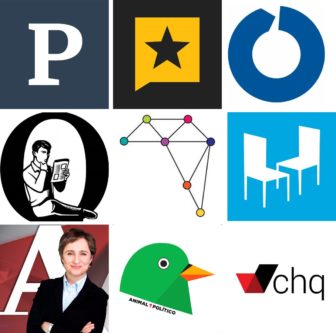

Credibility Is the New Currency. And that’s Good for Independent Media
 An organization that promotes development of independent media in Latin America, SembraMedia.org, recently asked communications lecturer and former Columbus Dispatch business journalist James Breiner to make some journalism predictions for 2018. He had one:
An organization that promotes development of independent media in Latin America, SembraMedia.org, recently asked communications lecturer and former Columbus Dispatch business journalist James Breiner to make some journalism predictions for 2018. He had one:
“Credibility will be the new currency of journalism in 2018 and the years to come.”
To explain, here are that prediction’s corollaries:
Independent media — those based on serving the public rather than turning a profit — will grow in importance through revealing corruption and holding authorities accountable.
There are many examples. In the US, organizations such as ProPublica and Texas Tribune; in Spain, eldiario.es; in Peru, OjoPúblico; in Colombia, Connectas and La Silla Vacía; in Mexico, Aristegui Noticias and Animal Político; in Argentina, Chequeado; and hundreds of others around the world.
These independent media that serve the public first, rather than political or economic interests, will gain credibility by challenging the powers that be.
That credibility will have economic value that will be monetized through support from NGOs, foundations, consumers, wealthy donors and service-oriented organizations.
Journalism will continue its transformation from a business to a public service, and traditional media that view journalism as a business will accelerate their own decline.
The traditional media’s focus on maintaining profit margins will cause them to continue gutting their staff, their products and their services. They will have neither the will nor the means to make the needed investments in personnel and technology to transition to the world of multimedia, interactive, multi-platform and interactive journalism. (There are a handful of exceptions.)
Independent public service media will broaden and deepen their impact through collaborations across borders, between institutions and among other media.
 Examples: ProPublica’s support of investigative journalism on the local level; NPR’s translation and distribution of Radio Ambulante, a Spanish-language podcast about Latin America; Ojo Publico of Peru’s collaboration with other Latin American media on the Panama Papers and international trafficking of stolen art objects.
Examples: ProPublica’s support of investigative journalism on the local level; NPR’s translation and distribution of Radio Ambulante, a Spanish-language podcast about Latin America; Ojo Publico of Peru’s collaboration with other Latin American media on the Panama Papers and international trafficking of stolen art objects.
Telling truth to power will be riskier.
Independent media will be mercilessly attacked by the people and organizations that are threatened by watchdog journalism. These media will suffer denial-of-service cyber attacks, smears of their organizations and individual journalists in social media, even threats and violence against themselves and their families. Credible, verifiable information has economic value; thus publishing it exacts a high price.
Because of these attacks, public-service media will need technical, legal and training support from many organizations that support freedom of information.
Among such organizations that are already helping are the Global Investigative Journalism Network, the International Consortium of Investigative Journalists, the Committee to Protect Journalists, Reporters without Borders, the International Center for Journalists, and many others.
For the first time, consumers of media will become the primary source of revenue for journalism rather than advertisers.
The support will come in various forms with various names: crowdfunding, donations, partnerships, memberships, clubs, societies. The key will be for the media to establish a relationship of trust, confidence and loyalty with their audiences by providing credible, actionable news and information on topics they care about: health, education, the environment, technology, the economy and other topics neglected by major media. In most cases, the people who actually pay for news will be a small percentage of users, but their total support will be significant.
New metrics of engagement and loyalty will be developed to help independent media monetize their audiences.
The old metrics of total views and total unique users will be replaced by those that capture time spent on an item, the displacement of a cursor on a page, where a user’s eyes focus, which shared items were actually read or viewed and others.
The Facebook-Google duopoly will tighten its stranglehold on digital advertising around the world, but the related advertising fraud will create opportunities for public-service media.
The automated buying, selling and targeting that has taken over digital advertising has spawned alongside it an illicit industry on massive scale in which robots rather than humans generate page views and video plays. Many major global advertisers, who have lost hundreds of millions of ad dollars to this fraud, have cut back or eliminated their digital ad spend, as Craig Silverman has documented in his investigations. The opportunity for public-service media? They offer sponsors and advertisers a credible media environment for their messages.
New digital media will lead the innovation in new forms of storytelling.
Porcentual of Spain, for example, has 60 media clients who subscribe to its service that provides graphics of data pulled from government databases on unemployment, health, pensions and other economic indicators. La Silla Vacia of Colombia provides visual maps of the connections among the most powerful people in the country. Podcasts like How I Built This offer media the chance to capture the sustained attention of users, and thus generate new sponsor revenue. These media have the agility to innovate and experiment.
It will be a good year for independent digital media in 2018.
Despite all the challenges. I’m an optimist.
This post originally appeared on the blog News Entrepreneurs and is re-published with the author’s permission.
 James Breiner is a consultant and visiting professor at Spain’s University of Navarra. He is former director of the Global Business Journalism program at China’s Tsinghua University and founding director of the University of Guadalajara’s Center for Digital Journalism. He has worked as publisher, editor and I-team leader.
James Breiner is a consultant and visiting professor at Spain’s University of Navarra. He is former director of the Global Business Journalism program at China’s Tsinghua University and founding director of the University of Guadalajara’s Center for Digital Journalism. He has worked as publisher, editor and I-team leader.









